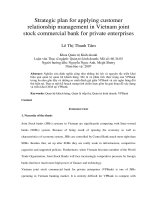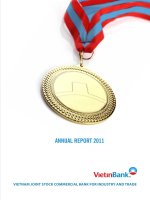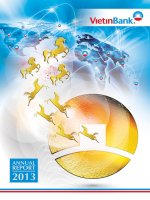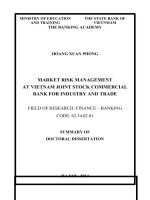Strategic plan for applying customer relationship management in Vietnam joint stock commercial bank for private enterprises
Bạn đang xem bản rút gọn của tài liệu. Xem và tải ngay bản đầy đủ của tài liệu tại đây (363.76 KB, 24 trang )
Strategic plan for applying customer
relationship management in Vietnam joint
stock commercial bank for private enterprises
Lê Thị Thanh Tâm
Khoa Quản trị Kinh doanh
Luận văn Thạc sĩ ngành: Quản trị kinh doanh; Mã số: 60.34.05
Người hướng dẫn: Nguyễn Ngọc Anh, Megh Shetty
Năm bảo vệ: 2007
Abstract: Nghiên cứu định nghĩa cũng như những lợi ích và nguyên tắc triển khai
hiệu quả quản trị quan hệ khách hàng. Mơ tả và phân tích thực trạng của VPBank
trong ba năm gần đây và những so sánh đánh giá giữa VPBank và các ngân hàng đối
thủ hiện tại. Đưa ra một kế hoạch mang tính chiến lược gồm ba giai đoạn để xây dựng
và triển khai CRM tại VPBank
Keywords: Quan hệ khách hàng; Quản lý tiếp thị; Quản trị kinh doanh; VPBank
Content
INTRODUCTION
1. Necessity of the thesis
Joint Stock banks (JSBs) systems in Vietnam are significantly competing with State-owned
banks (SOBs) system. Because of being result of opening the economy as well as
characteristics of economy system, JSBs are controlled by Central Bank much more tight than
SOBs. Besides that, set up after SOBs they are really weak in infrastructure, competitive
capacities and supported policies. Furthermore, when Vietnam becomes member of the World
Trade Organization, Joint Stock Banks will face increasingly competitive pressure by foreign
banks that have much more high power of finance and technology.
Vietnam joint stock commercial bank for private enterprises (VPBank) is one of JSBs
operating in Vietnam banking market. It is entirely difficult for VPBank to compete with
SOBs. However, VPBank is opposing increasing competition of Joint Stock competitors in
order to exist and development.
Moreover, I have been working in VPBank, one of the first Joint Stock banks in Vietnam, as
an officer for nearly three years.
2. Objectives of the thesis
Based on defining difficulties of VPBank in terms of competing with not only other non-state
banks but also state-owned banks, the research will significantly find out a relevant
competitive strategy for VPBank in the period from 2006 to 2010 and answer Why VPBank
should apply CRM as a competitive tool.
To get the general objective the research thesis will take detail objectives: i) examining main
effects of external and internal environment on VPBank’s operation; ii) finding a relevant
competitive strategy for VPBank in next five-year period and the relationship between
VPBank new competitive strategy and CRM; and iii) how to apply CRM at VPBank.
Questions
To achieve these objectives above, the dissertation will answer three key questions follow:
1) What factors have significantly affected operations of VPBank?
2) What will be competitive strategy for VPBank in 2006 – 2010 and the relationship
between the new strategy and CRM?
3) How to apply CRM solution?
3. Methodology
To find a relevant strategy for VPBank, the thesis will analyze competitive advantages based
on analyzing SWOT and value chain.
Data is definitely collected from secondary data source. They are government’s reports,
Central Bank’s annual reports, legal documents related to banking system, VPBank’s
2
Annual reports, VPBank’s surveys and banking articles. Besides that, the research uses
data collected from other Joint Stock Banks and State-owned Banks.
The research also uses comparison and contrast methods in order to answer the research
questions.
4. Structure of the thesis
To regard to the research topic, the research is clearly divided into three chapters including:
Chapter 1: Literature Review
Chapter 2: Background on Vietnam banking market and VPBank situation analysis
Chapter 3: Recommendation on competitive Strategy of VPBank in 2006-2010, and how to
apply CRM solution as a competitive tool.
CHAPTER 1: THEORICAL FRAMEWORK
1.1 The definition of customer relationship management (CRM):
1.1.1 Definition of customer relationship management:
There is no universal explanation of what CRM is, since the area is fairly new and still is
developing. It is therefore important to remember that several attempts of defining CRM exist
and that many companies adapt the definition to their own business and their unique needs.
The following quotations are three examples of how CRM is defined:
“CRM is a new customer-centric business model that reorients firm operations around
customer needs (as opposed to products, resources, or processes) in order to improve
customer satisfaction, loyalty and retention”
“CRM is the integration of customer focus in marketing, sale, production, logistics and
accounting, i.e. in all parts of the company’s operations and structure”
“The activities a business performs to identify, qualify, acquire, develop and retain
increasingly loyal and profitable customer by delivering the right product or service, to the
3
right customer, through the right channel, at the right time and the right cost. CRM
integrates sales, marketing, service, and enterprise resource planning and supply-chain
management functions through business process automation, technology solutions, and
information resources to maximize each customer contract. CRM facilitates relationships
among enterprises, their customers, business partners, suppliers, and employees”
1.1.2 Comparison between relationship and transactional marketing:
The transactional marketing focuses on the capability of taking over new customers, attracting
the potential customers from competitors while relationship marketing focuses on the
capability of protecting the market share in the market, keeping close relationship with the
current customers, cross-selling and up-selling.
1.2 The principle of CRM
The principle of CRM is that all customers are not the right customers, so in CRM each
customer group will be treated in the different ways.
The remaining customers represent potential relationship buyers. They can be divided into
three district segments:
-
Those who are significantly the most profitable;
-
Those who are delivering good profit and suggest the capability of becoming top profit
customers;
-
Those who are only marginally profitable.
The first group of buyers: Those customers who represent 10% of the company’s
business and are the most profitable should be the first to be targeted for CRM. The
purpose of the CRM efforts will be retention. Even although it may be difficult to
make these customers more profitable, CRM should help assure that none of them are
lost to the competition.
The middle group of buyers: The balance of the customers in top 40% or 50% as
ranked by sales and profit. It will be just as important to target this middle group of
buyers who are delivering good profit but may be capable of moving up to the top of
4
profit level. Customers in this group are probably giving some of their business to
your competitors. CRM activities for these customers should be aimed directly at
increasing your company’s share of their business. CRM marketing strategy developed
for this middle group of buyer more than paid for the company’s significant
investment in database software within a year.
The final, less profitable, group of customers: The third group of customers represents
those who, while profitable, are only marginally so. While it is possible that some in
this group would move up the sales ladder as a result of increased communications, it
will probably not be worth the effort. Typically, this group will represent almost half
of the customer file. Hence this simple analysis has greatly reduced the size of the
challenge of implementing CRM.
1.3 The element of CRM:
CRM consist of three elements: People, Process and Technology, that help companies to
understand their customers. To gain the success in CRM project, the company must
coordinate all aspects.
Technology must be given a 20% weight, while people and business process should be 50%
and 30% respectively.
1.4 The characteristics and the challenges of CRM:
1.4.1 The characteristics of CRM:
Customer database centrally: Give to the company a overall view of relationship of
each customer.
Profitability of customer analysis: CRM helps to create the balance sheet of individual
customer, and helps the company to invest more effectively on each customer, the
profitability is the most important thing to evaluate and classify customers. Normally,
each company has three classes of customers:
5
-
The first class: Take about 10% of total customers, this class makes the highest profit
and has long-term transactions with the company.
-
The middle class: Take about 40%-50% of total customers, this class makes profit and
is very potential.
-
The last class: Also take about 40%-50% of total customers, the profit of this class is
not high and mainly is the current customers who have few transactions or only come
to the company in some special occasions like sale-off, discount...
Customer segmentation: CRM classifies customers into different segmentations and
measures the effectiveness of each segmentation.
Marketing campaigns base on customer database: Use the database and information of
each segmentation to plan and implement marketing campaigns
Analysis of customer’s needs: Help to give personalized product or service to each
customer and find more new and potential needs from customers to compete with
competitors.
1.4.2
The challenges of CRM:
Have to change the policies and process in the whole
Need full support from the board of management and all staffs, for example: the way
they import the customer information to CRM system and dig this database...
Need large initial cost to invest on software, machine, equipment and human
resource...
6
1.5
Ideas support CRM:
1.5.1 The statistics of Harvard-Business review in December, 1995:
-
Only 4% of dissatisfying customers complain, the other say nothing but they will
come to your competitors. In the banking industry, 65% of customer will chose other
suppliers if they are not satisfied.
-
The average person with a problem eventually tells nine other people
-
Satisfied customers tell 5 other people about their good treatment
-
The cost of acquiring a new customer is 5 to 7 times greater than retaining current
ones
-
The cost of recruitment a new employee is 10 times greater than retaining current ones
1.5.2 Pareto's Principle - The 80-20 Rule:
The 80/20 Rule means that in anything a few (20 percent) are vital and many (80 percent) are
trivial. In Pareto's case it meant 20 percent of the people owned 80 percent of the wealth. In
Juran's initial work he identified 20 percent of the defects causing 80 percent of the problems.
Project Managers know that 20 percent of the work (the first 10 percent and the last 10
percent) consumes 80 percent of your time and resources.
CHAPTER 2: BACKGROUND ON VIETNAM BANKING MARKET AND VPBANK SITUATION
ANALYSIS
2.1 Overview of Vietnam Banking Market
State Commercial Bank: There are 6 banks of this type now running their business. These
banks own a large system of branches that can join Inter-bank independently or dependently
owing to its policy and management capacity or they can choose not to join Inter-bank
market.
Joint-Stock Commercial Bank system consists of 37 members. It is now seeing a decline in
number but an increase in scale for each member
Joint-Venture Bank, foreign bank branches: 4 Joint-Venture Banks and 27 foreign bank
branches are in operation in Vietnam. Their customers are mainly foreign financial groups or
7
joint-venture companies. Several banks of this kind such as City-bank or Standard &
Chartered Banks have been offering services in Inter-bank, though still humble.
Financial companies: 5 financial companies that seem unable to afford big business due to
shortage of long-term capital want to switch to Inter-bank market. Most of these companies
lack of banking tools. These banks offer services mainly in sending and lending money, bond
transactions, and moneyed papers.
2.2 Situation of VPbank
2.2.1 Vision
Up to 2010, VPbank will become the first-ranked commercial bank in the northern of
Vietnam in the credit service; especially installment consuming loans and VPBank difference
is created by effective customer relationship management.
2.2.2 SWOT Analysis
Strength:
- Firstly, Vpbank has the quick growth rate in mobilizing funds, especially in savings. You
can see the total mobilized funds in the period 2001-2004, as below:
Total customer’s deposits in the period 2001-2004
Unit : Mil VND
Criteria
2002
2003
%
2004
%
Customer’s deposits
974,632
1,273,993
30.72%
1,869,589
46.75%
* Savings account
797,116
1,032,513
29.53%
1,541,341
49.28%
* Current account
134,697
210,371
56.18%
283,198
34.62%
42,819
31,109
-27.35%
45,050
44.81%
* Others
So, the growth rate in mobilizing fund is quick, it is because VPBank always offers the
attractive mobilized interest rate, as compared with other Vietnam commercial banks and
VPbank often provides many promotion programs or advertisements. The customer’s deposits
8
come from 30.7% to 46.7% during the two years 2003-2004, including that savings take the
most percentage.
Mobilizing fund growth rates in 2003-2004
0.76
0.47
0.40
0.33
0.24
VPbank
ACB
Exim
Techcombank
Saigon Cong
Thuong
Source: VPBank, ACB, Eximbank, Techcombank, Saigon Cong Thuong bank’s anual
reports 2003-2004
- Secondly, VPBank has a young and skillful human resource. The graduated and upper
graduated employees take 74% of total employees, and two-third is the new comers. Of
course, it says nothing, the most important thing is the capability of adapting with the new
environment, processing the task but the youth will bring the fresh environment and be more
active and creative.
- Thirdly, the NPLs rate over the total loan balance in VPBank is low at the current time.
After VPbank was in Hanoi state bank’s special control with the NPLs rate 37% (2001), this
current rate is only 0.5% (2004). The number can say that VPbank are operating very safely.
- Forthly, VPBank has the strong relationship in the inter-bank market. It helps VPBank
increase the profit that comes from the inter-bank market investments, securities trading…At
the current time, these activities are mainly feeding all VPBank system.
9
Weakness:
- Firstly, sparse experienced managers and staffs, insufficient pool of good staff for expansion
- Secondly, management and control still a distance from good banking practices
- Thirdly, lower reputation compared to leading competitors
- Fourthly, small and high risks customer base
- Fifthly, varying service quality, small range of products and services
- Sixthly, VPBank weak point is the information technology system, the software that
VPBank is applying is not very useful anymore because the demand of customers is
developing; they want to buy modern bank services. While other competitors have finished
the modernizing-bank project, VPBank still use B2K. With new application software, the
competitors can deploy some new services that attract customers like mobile-banking,
home-banking…Although these services are not popular with the medium and low income
customers now, they promote brand names for VPBank’s competitors.
Opportunity:
- Firstly, it is the high entry for the new comer. In fact, to open a new one, the legal
regulations are required so complexly. Moreover, the state bank’s guideline is to build the
really strong commercial banks to compete with the foreign ones, they do encourage opening
more new small banks. With VPBank, the domestic competitors do not arise but it is easy to
appear the merge and acquisition trend in the future. The competitors are the current domestic
banks, foreign banks, and the financial companies that provide the same services such as
insurance company, post office savings, and securities exchange…
- Secondly, Vietnam government are maintaining the market economy, so in the future the
growth rate of Vietnam economy goes up stably and firmly. This environment encourages the
private economy sector to develop; this is also the target market of other retail banks and
VPBank.
10
- Thirdly, the habit of Vietnamese people is changing day by day, the new generation has
newer thinking, newer habit. The intellectual has the high and stable income; they want to be
independent with their parents when they are still young. It will increase the demand of
instalment loans for purchasing car, house… Besides, Vietnamese people are turning into
using non-cash payment, they will use plastic and chip payment cards like ATM, Credits
card…This is the big opportunities for banks including VPbank.
- Fourthly, the banking industry has the potential development trend and high profitability, at
this time the stocks of commercial banks are so attractive in the investors’ eyes. This
opportunity still offer to other bank like VPBank, they still keep investors’ belief because
Vietnam commercial banks’ strategies are to develop stably and firmly and to reduce the risk
as much as possible.
Threat:
- Firstly, SOCB reform resulting in SOCB’s targeting SME segment
- Secondly, leading competitors have accelerated
- Thirdly, foreign banks preparing for market penetration
- Fouthly, non-bank financial services: insurance, leasing, postal savings are potential threats
- Fifthly, Vietnam’s economy is still high-risk
- Sixthly, many sectors are facing difficulties with economic integration
2.2.3 Value chain analysis
After taking value chain analysis and comparing with some selected competitors. We can
understand where VPBank is standing in the market and what competitive advantages from
VPbank are better than others. VPBank does not expose anything that is the best, VPBank
only has some points that are relatively strong and able to compete (not much worse than
VPBank’s competitors), they are credit business and service after sale. In order to strengthen
VPBank’s competitive advantage, they should apply CRM.
11
CHAPTER 3: RECOMMENDATIONS TO BUILD A STRATEGIC PLAN FOR APPLYING CRM IN
VPBANK
With the competitive strategy above in 2006-2010 period, the application plan of CRM
program is divided into 3 phases:
+ The first phase (2006-2007): Build foundation for CRM, especially VPBank customer
database
+ The second phase (2007-2009): Deploy CRM
+ The third phase (2010): Review, evaluate and develop CRM
3.2.1 The first phase: Build foundation for CRM
CRM is a long-term program with the success ratio that is only 50%. However most of
the successful companies are small and medium ones, VPBank must have the
preparation period in order to build the foundation for CRM.
As analyzed in the theory part, CRM consists of three elements: People, Procedure and
Technology. So, what does VPBank have to do for this phase?
3.2.1.1 VPBank has to prepare “people”
VPBank must build a core team for CRM application. They are the key persons for the
whole project; they come from all departments for example: the board of management,
deposit, credit, and accounting….
Some basic requirements to recruit human resource for CRM core team:
+ Have long experience in VPBank
+ Come from all departments
+ No need long experience in IT
+ Need one person who will be expert at the changes and procedure management
12
The tasks of CRM core team:
+ Evaluate and analyze the current situation of customer relationship management at
VPBank
+ Propose the strategy and objectives for CRM program
+ Notice and transmit not only the ideas but also the method of implementing CRM as
well to all the employees. Consistently, all the staffs have to understand the customercentric culture.
+ Choose the suitable information technology system like software and hardware for the
selected strategies of CRM.
+ Control the process of implementing CRM
3.2.1.2 VPBank must build the plan for selecting CRM vendor
VPBank must build the plan for selecting the suitable supplier of CRM information
technology. IT is not the key element to decide the success or fail of CRM project but we
can not be lack of one information technology. Study CRM strategies and demands of
VPBank carefully before purchasing.
3.2.1.3 VPBank must improve customer database
In the first step to implement CRM at VPbank, we must build a qualified customer
database; it is the foundation of CRM. With VPBank current rag and desultory
customer database, we need to complete and improve it. The current number of
VPBank customer is so small, so we have to find and attract more new customer in this
phase. CRM bases on the qualified customer database, it means that we must have a
certain number of customers with their clear profile.
There are some activities that help VPBank to attract more new customers, especially in
the credit business- the strategic business of VPBank:
13
o Create the close relationship with the middleman in housing and land trading
and the construction companies.
o Associate with the head hunting companies to have the list of high-income
employees because they are the potential customers (young, risk-taker, high and
stable income) for VPBank services. After that VPbank approaches these
subjects by providing the prefer cards, customer care. They are the target
customer of consuming loans.
o Organize the meeting in some enterprises to market for VPBank product and
service. This is the chance for both VPBank and the employees in those
enterprises; VPbank can offer some prefer policies for them. And this must be
the win-win relationship because of CRM long-term strategies.
o The students, who are in the last year or have just graduated, are also the
potential customers for VPBank. Maybe, in the current time they have not so
much demand of banking services but in the near future everything will change.
So, VPBank should approach these subjects but with the limited resources,
VPBank only concentrates on the best-graduated students. VPBank will apply
the special customer care policies for this group, for example: VPBank will
provide the card named “Vietnamese talent” for them, with this card they can
receive birthday’s gift, discount fee or other prefer policies…
3.2.1.4 Evaluating activities
We need a year for this phase, after one year VPBank must have some KPI to evaluate
for the preparation of the CRM foundation, they are:
The number of new customers (this is the most important thing)
The customer database (completeness, clearness, and qualification…)
Turnover from VPBank credit business.
14
The customer retention and the percentage of customers who go away (closed
accounts, non-performing accounts…).
3.2.2 The second phase: Deploy CRM
After one year preparing for CRM application, now the main objective is not to find new
customers, the main objectives in this phase as below (within three year):
Finish procurement, and deploy the software of customer relationship management at
VPBank
Train the employees from all levels, all departments about not only the tasks and
functions that are changed when VPBank applies CRM but also the serving and
communicating skill in the new environment.
Standardize all steps in the procurement to bring the best and stable quality services to
customers (one of the main limitations in service industry is inconsistent in the service
quality; it is affected by people and information technology).
Classify VPBank customers and creat action plan for building customer relationship at
VPBank.
3.2.2.1 CRM software application
CRM software is the important tool to help VPBank not only collect and record the
information from their customers but analyze and forecast the demand of customers in the
current period or near future as well. VPBank will meet all demands completely and perfectly
and they will understand their customers deeply, they can build the relationship based on the
customers’ wishes, habits, and needs. After that VPBank customers will not see VPBank as a
normal company but as a close friend. This relationship is based on the WIN-WIN
foundation.
15
Customer
-
VPbank
Be offered prefer policies and
-
The profit margin in the individual
special care.
customer may be reduced but the
-
Save costs
total profit will increase.
-
Be met maximum the demand
-
Save costs
-
Create well-known brand and
differentiation from competitors.
-
Develop stably and firmly
After defining the mission and strategy and application solution of CRM at VPBank, the core
team has to raise the customer relationship management requirements for the tender. About
customer information collection, the CIF module from all core bank solutions can meet,
however this module can not provide analysis and evaluation tools and create the model of
analyzing and forecasting the demand, the risk of customers in order to support VPBank to
build and maintain the relationship
3.2.2.2 VPBank employee training:
In the CRM implement process, the people are the key factor to succeed. CRM concentrates
on creating and maintaining the relationship between VPBank and customers, so the staffs
will the face of VPBank. They are representatives for VPBank to communicate, to serve and
to keep the relationship with customers. The objectives and the benefits of CRM are
understood and committed much clearly by VPBank staffs. According to the statistic from
Havard business review, the failure of CRM is not mainly from CRM software solution but
mainly from each individual person in the company. They do not commit and perform
inconsistently from the board of management to the employees.
16
3.2.2.3 Accomplishment of standardization of the procedure
The benefits of standardization of the banking procedure are as followings:
-
Improving the prestige and making differentiation for the bank
-
Improving efficiency and easily evaluating work of each staff
-
Saving time for customers and facilitating them in transactions with the bank
-
Reducing errors in work
The change and standardization of the procedure should be clearly declared and lectured
to each staff to ensure that all the customers of the whole system of the bank are served in
a speedy and professional manner.
3.2.2.4 Classification of customers
It depends on the target of the bank in implementing CRM that the bank could choose certain
criteria to classify customers. For example, the bank chooses Profitable Capability and
Satisfaction Level to classify customers:
Profitable Capability reflects potentiality to create turnover.
Satisfaction Level reflects satisfaction and feelings of customers with services
Profitability
Satisfaction
-
The red box shows customer group that provides the highest profitability and satisfy
perfectly with VPBank services. Certainly, this rate of this customer group is not high
compared with the total number. But only small ratio can makes the considerable
17
profit for the bank. If they go to another bank, VPBank will lose so much. One
customer of this group can create the profit that is ten or hundred times bigger than
normal.
-
The yellow box shows the customer group that brings the highest profit but has
average satisfaction or the one that bring the average profit but satisfy perfectly with
VPBank services. They are the subjective that CRM should impact and VPBank
should use some CRM policies to bring them to the first group
-
The blue box shows the customer group that provides the highest profitability but
dissatisfies with VPBank services or the one that has the low profitability but satisfy
perfectly. They are the customers that VPBank must pay attention and consider
carefully because it is very easy for them to say “good bye” with VPBank and only
low profitable customers stay.
-
The grey box show the customer group that has the average profitability, dissatisfy
with VPBank and has the low profitability, average satisfaction. VPBank cannot put
additional marketing cost for this group.
-
The black box shows the low profitability and low satisfaction. VPbank can forget this
group.
Based on each type of group, the bank must plan:
+ Budget
+ Human resource
+ Customer care policies
3.2.2.5 Some customer relationship solutions and customer services for VPBank
In this phase, VPBank has supports from CRM software solution; all the customers will be
divided into different groups like above. In order to influence the customer behavior,
18
especially the old customers in VPBank, the customer service department must know what
their customers are thinking and caring.
When VPBank has already CRM solution, it means that VPBank will not launch so many
other marketing campaigns anymore. The most impotant thing is the long-term relationship.
Some loyalty solutions:
-
Customer consuming behavior
-
Motivation in both physical and spirit
-
Social activities.
Some motivated ways as below:
-
Mail, e-mail, SMS message, fax... Congratulation letter, thank letter...
-
Website: Exchange information, collect the ideas and comments from customers
-
Prefer card, monthly banking magazine, and postcard, catalogue on some special
occasions...
-
Directly meeting: Focus group, private meeting.
-
Call center: Maximize the capability of meeting customers’ demand, customizing and
consulting.
-
Gift and Discount: The more customers make profit for VPBank, the more benefit
they get.
Some incentives to spending activities of customers :
o In sense of spirit:
-
Keep in mind the name of customers
-
Associate, organize and issue member card for customers in activities such as
bodybuilding, tennis, swimming, dancing, etc.
19
-
Note down important anniversaries of each customer such as birthday, wedding day,
special days, for example give birth to a child, etc. The bank should send flowers
and/or gifts and/or greetings cards for congratulations.
-
Send thankful cards to customers on specials days in various ways
-
Send news, magazines periodic updated information of the bank and customeroriented descriptions of services and instructions of procedure (the easiest the best) to
customers.
-
Establish central switchboard 24/24 availably give answers to all questions and
comments as well as consult usage of appropriate banking services to customers.
-
Make call to customers to inquire after and inform them about new policies in case
they have no transactions with the bank for a certain/stipulated period of time or
intend to use banking services of other banks.
o In sense of material:
There are many ways to encourage the spending activities of customers. Most of
companies that implement CRM issue cards for royal customers. CRM software solutions
could make score for customers based on the turnover derived from them. Upon various
numbers of total score, the bank will grant out many options of rewards for customers.
Herewith are some of the rewards granted to customers
-
Reduced price and fee of banking services
-
Rewards and preferred interest rates
-
New products without fee in certain time
-
Preferred prices when using non-banking services such as restaurants, hotels, tourism,
cosmetic, household utensils, etc.
-
Credit guarantee in certain cases
20
3.2.2.6 Evaluation
It depends on kind of customers that the bank choose the appropriate customer incentive
policy. It is noted that this is the most important phase in implementing CRM plan at the
bank. The success of this phase could determine the success of the whole program. The
estimated time to perform and evaluate the result of CRM in this phase is three years,
however it is required to annually review and evaluate the performance. Hereunder are some
important criteria (KPI) in this phase:
-
The profit growth of the bank
-
Average profitable capability of each customer
-
The number of customers of “diamond” and “gold” group in certain time
-
Average returns on investment cost (cost for relationship with customers) ratio and
ROI for each kind of customers.
-
Make comparison of average returns on investment cost ratio between pre and post
CRM
-
Do periodic researches to evaluate comments and feelings of customers.
-
Number and ratio of customers that do not use the bank’s services anymore in certain
time
-
Profit ratio derived from the customers that leave the bank in certain time
-
Number of new customers (In implementing CRM, the target is to maintain the current
customers, however, it is the advantage of CRM that attracts more new customers)
3.2.3 The third phase: CRM development
Some of CRM solutions of privatization:
-
Arrange account manager: arrange certain account manager serving the whole services
to each royal and important customer.
21
-
Individualization in communications with customers. Each customer wants to be
respectfully treated; hence, individualization is very important. It could be done
through call/mail to require after or advise information of the bank, etc. All of the
channels should be directed to customers with real name.
-
If it is possible, the bank will offer customer-oriented products.
-
Customer researches should be individualized too. This will make a greater efficiency
because customers will be respectfully treated and in turn, giving out precise and
careful answers.
-
Marketing activities are directed to certain customers (marketing one to one). Each
customer is differently characterized; hence they need to be differently treated in order
to get the best result from them. For example, on the chance of 8/3 or 20/10, the bank
should send flowers to female ones with various kinds, etc.
3.2.4 Conclusion
The competition on the market is increasing domestically as well as globally. Nowadays, if
one bank operates without any competitive advantage, it is not sure that the bank can no
longer exist. In order for VPBank to survive and grow they must find the new way of thinking
to operate. Banking industry is the special one; it cannot live without the customers’ belief.
Given the competitive nature of the banking business with its intricate diverse demands today,
nurturing and deepening customer relationships is integral to any bank’s success. After all,
satisfied customers are loyal customers, their retention rate is much higher and so is their
overall profitability for the bank. As it happens, CRM offers the most holistic route for banks
to enhance customer relationships. A powerful CRM solution provides a complete perspective
of a customer’s relationship with the bank across multiple channels like e-mail, telephone,
IVR, branch, web chat and across multiple products ensuring that every bank employee is
better informed to deal effectively with customers and their needs. It enables banks to
22
understand their customer's expectations and preferences better and offer the potential to
deliver higher levels of personalized service and more effectively implement cross-selling and
up-selling strategies. By doing so, banks can enhance customer retention, profitability and
loyalty and get an increased “share of wallet” from their customers. Further, in the face of the
recent spate of Know Your Customer (KYC) regulations, CRM systems provide the optimum
solution to the need for unified customer data, information and intelligence.
So, the effective way to keep customer in the long term is customer relationship management
(CRM). The goal with CRM is to maximize the company profits by maximizing the value of
interaction with the customers. And this chapter 3, there are recommendations a plan to
VPBank how to build an effective CRM program.
References
1. Arthur Middleton Hughes. The Customer Loyalty Solution: What Works (and What
Doesn't) in Customer Loyalty Programs. McGraw-Hill
2. Brock Richard and et al. 2000. Profitable Customer Relationships: The Keys to
Maximizing Acquisition, Retention, and Loyalty. Apastore Inc
3. Frederick Newell. Why CRM Doesn't Work: How to Win by Letting Customers
Manage the Relationship. Bloomberg
4. Michael T. Bosworth and John R. Holland. Customer Centric Selling. McGraw-Hill
5. Neil Woodcock, Merlin Stone and Bryan Foss. The Customer Management
Scorecard: Managing CRM for Profit. Kogan Page Limited
6. Philip Blight and Douglas Turk. CRM unplugged releasing CRM’s strategic value.
John Wiley and Sons, Inc.
7. Sarah Dougan. Customer relationship strategies in financial services. Business
Insights Lmt
8. Tom Sant. Persuasive Business Proposals: Writing to Win More Customers, Clients,
and Contracts. Amacom
9. www.guru.com
10. www.asiabanker.com
11. www.vpb.com.vn
23
24









